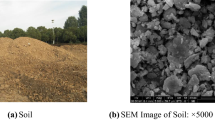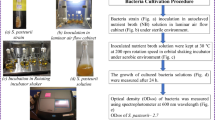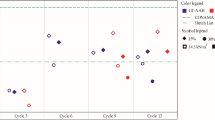Abstract
Uranium is a relatively active and chemically toxic natural radionuclide, its enrichment in the environment poses a serious threat to human health and ecosystems. It is necessary to dispose the uranium contaminated soil safely and efficiently. In this study, the effect of coal gangue-based geopolymers on the solidification of uranium-contaminated soil was examined using a single factor experiment. The highest compressive strength of the solidified body reached 24.6 MPa, and the highest fixation efficiency of uranium reached 77.44%. The results show that lower liquid-to-solid ratio, higher alkali activator content and lower alkali activator modulus promote the solidification of uranium.










Similar content being viewed by others
References
Deng G, Zhang Y, Luo X, Yang J (2018) Hydrothermal leather waste by hydrothermal method for uranium (VI) removal from a Simulated Saline Solution. Appl Organomet Chem 32(9):e4473
Bo L, Hongjuan S, Tongjiang P, Tao D (2019) Transport and transformation of uranium and heavy metals from uranium tailings under simulated rain at different pH. Environ Chem Lett 18(2):495–503
Nair RN, Sunny F, Manikandan ST (2010) Modelling of decay chain transport in groundwater from uranium tailings ponds. Appl Math Model 34(9):2300–2311
Abdelouas A (2006) Uranium mill tailings: geochemistry, mineralogy, and environmental impact. Elem 2(6):335–341
Ding H, Zhang X, Yang H, Zhang Y, Luo X (2019) Biosorption of U(VI) by active and inactive Aspergillus niger: equilibrium, kinetic, thermodynamic and mechanistic analyses. J Radioanal Nucl Chem 319(3):1261–1275
Neves O, Matias MJ (2007) Assessment of groundwater quality and contamination problems ascribed to an abandoned uranium mine (Cunha Baixa region, Central Portugal). Environ Geol 53(8):1799–1810
Tang H, Li Y, Huang W, Chen S, Luo F, Shu X, Tan H, Li B, Xie Y, Shao D, Lu X (2019) Chemical behavior of uranium contaminated soil solidified by microwave sintering. J Radioanal Nucl Chem 322(3):2109–2117
Falcigliaa PP, Cannatab S, Ursob G, Scandura P, Vagliasindi F (2013) Development and Application of a mathematical model for the assessment of the treatability of radionuclides polluted soils by microwave heating stabilisation: preliminary results. Chem Eng J 32:373–378
Krawczyk-Barsch E, Lutke L, Moll H, Bok F, Steudtner R, Rossberg A (2015) A spectroscopic study on U(VI) biomineralization in cultivated Pseudomonas fluorescens biofilms isolated from granitic aquifers. Environ Sci Pollut Res 22(6):4555–4565
Jiang F, Guo J, Wang X, Liu Y, Li X, Chen G, Wang Z, Yang J, Tan B (2020) Experimental study on the leaching performance of U(VI) solidified by uranium tailing cement with different admixtures and ratios. Environ Technol Innov 17:100506
Donald IW (2010) Waste immobilization in glass and ceramic based hosts. John Wiley & Sons, London, Chippenham
Huang X, Huang T, Li S, Muhammad F, Xu G, Zhao Z, Yu L, Yan Y, Li D, Jiao B (2016) Immobilization of chromite ore processing residue with alkali-activated blast furnace slag-based geopolymer. Ceram Int 42(8):9538–9549
DAVIDOVITS J, (1989) Geopolymers and geopolymeric materials. J Therm Anal 35(2):429–441
Ji Z, Pei Y (2019) Bibliographic and visualized analysis of geopolymer research and its application in heavy metal immobilization: a review. J Environ Manage 231:256–267
Jiali L, Shukui Z, Lishan R, Jiang X, Linyu T, Luoing C (2020) A review on treatment of heavy metal using geopolymer technique. Fine Chem 37(07):1343–1351
Shujie Z, Faheem M, Lin Y, Ming X, Xiao H, Binquan J, Ning L, Dongwei L (2019) Solidification/stabilization of municipal solid waste incineration fly ash using uncalcined coal gangue–based alkali-activated cementitious materials. Environ Sci Pollut Res 26(25):25609–25620
Datong Z, Wenyi W, Xiamimg B, Jidian Y (1999) Method of testing cements-determination of strength. The state bureau of quality and technical supervision, Beijing, China
Chinese Research Academy of Environmental Sciences (2007) Solid waste-extraction procedure for leaching toxicity-Acetic acid buffer solution method. The state Environmental Protection Administration, Beijing, China
Tessier A, Campbell PGC, Bisson M (1979) Sequential extraction procedure for the speciation of particulate trace metals. Anal Chem 51(7):844–851
Xiao J, Zhou SK, Chu LP, Liu YJ, Li JL, Zhang J, Tian LY (2020) Electrokinetic remediation of uranium(VI)-contaminated red soil using composite electrolyte of citric acid and ferric chloride. Environ Sci Pollut Res Int 27(4):4478–4488
Pan Y, Wu Z, Zhou J, Zhao J, Ruan X, Liu J, Qian G (2013) Chemical characteristics and risk assessment of typical municipal solid waste incineration (MSWI) fly ash in China. J Hazard Mater 261:269–276
Li S, Huang X, Muhammad F, Yu L, Xia M, Zhao J, Jiao B, Shiau Y, Li D (2018) Waste solidification/stabilization of lead–zinc slag by utilizing fly ash based geopolymers. RSC Adv 8(57):32956–32965
Liew Y-M, Heah C-Y, Mohd Mustafa AB, Kamarudin H (2016) Structure and properties of clay-based geopolymer cements: a review. Prog Mater Sci 83:595–629
Rees CA, Provis JL, Lukey GC (2007) In situ ATR-FTIR study of the early stages of fly ash geopolymer gel formation. Langmuir 23(17):9076–9082
Jaarsveld JGSV, Deventer JSJV (1999) Effect of the alkali metal activator on the properties of fly ash-based geopolymers. Ind Eng Chem Res 38(10):3932–3941
Shi CJ, Jiménez AF, Palomo A (2011) New cements for the 21st century: the pursuit of an alternative to Portland cement. Cem Concr Res 41(7):750–763
Provis JL, Bernal SA (2014) Geopolymers and related alkali-activated materials. Annu Rev Mater Res 44:299–327
Vu TH, Van TM (2017) A review on immobilisation of toxic wastes using geopolymer technique. Springer, Singapore
Davidovits J (1994) Properties of geopolymer cements. First International Conference Alkaline Cements and Concretes, Ukraine, Kiev
Huang X, Zhuang R, Muhammad F, Yu L, Shiau Y, Li D (2017) Solidification/stabilization of chromite ore processing residue using alkali-activated composite cementitious materials. Chemosphere 168:300–308
Yaguang W, Fenglan H, Jingqiu M (2018) Solidification/stabilization mechanism of Pb (II), Cd (II), Mn (II) and Cr (III) in fly ash based geopolymers. Constr Build Mater 160:818–827
El-Eswed BI, M AO, I KF, (2017) Efficiency and mechanism of stabilization/solidification of Pb(II), Cd(II), Cu(II), Th(IV) and U(VI) in metakaolin based geopolymers. Appl Clay Sci 140:148–156
El-Eswed BI, Yousef RI, Alshaaer M, Hamadneh I, Al-Gharabli SI, Khalili; F, (2015) Stabilization/solidification of heavy metals in kaolin/zeolite based geopolymers. Int J Miner Process 137:34–42
Acknowledgements
This study was supported by the National Natural Science Foundation of China (No. 51174117), the Scientific Research Project of the Hunan Provincial Education Department (No. 17C0439) and Hunan Provincial Innovation Foundation for University, China (No. 201811528003).
Author information
Authors and Affiliations
Contributions
SZ: Writing- review & editing. JL: Data curation, Formal analysis, Investigation, Writing—original draft. LR, JX, YL, YD: Supervision, Validation. LC, QL, LY: Investigation. All authors read and contributed to the manuscript.
Corresponding author
Additional information
Publisher's Note
Springer Nature remains neutral with regard to jurisdictional claims in published maps and institutional affiliations.
Rights and permissions
About this article
Cite this article
Zhou, S., Li, J., Rong, L. et al. Immobilization of uranium soils with alkali-activated coal gangue–based geopolymer. J Radioanal Nucl Chem 329, 1155–1166 (2021). https://doi.org/10.1007/s10967-021-07812-x
Received:
Accepted:
Published:
Issue Date:
DOI: https://doi.org/10.1007/s10967-021-07812-x




